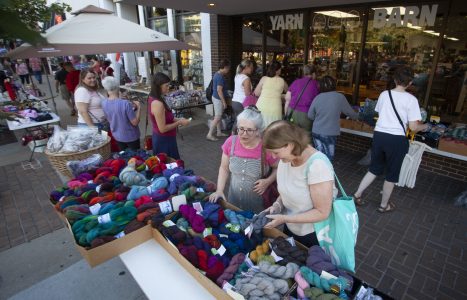
In what is now a monthslong trend, Lawrence sales tax totals rank near the bottom of the pack

photo by: Mike Yoder
Shoppers look over yarn products outside Yarn Barn, 930 Massachusetts St., during the 60th annual Downtown Lawrence Sidewalk Sale Thursday, July 18, 2019.
Not everybody was a winner this last Valentine’s Day. (Thinking that I had bought a box of chocolates to share with my beloved, for instance, was not a winning idea.) Lawrence’s economy was not among the winners in February either, but it had quite a bit of company, according to new sales tax figures from the state.
The Kansas Department of Revenue has released its April sales tax report (thinking Valentine’s Day is in April is definitely not a winning idea,) but because of normal delays in reporting, the April report primarily shows sales that were made in February.
For the month, Lawrence sales tax collections were down 1.4% compared with the same period a year ago. This marks the fourth time out of five months that Lawrence has posted a decline in sales tax revenues compared with the same month a year ago. By itself, that is not overly surprising. After all, we’re in a pandemic and certain types of businesses — restaurants, bars, theaters and many
other establishments that generally thrive in Lawrence — have had greatly reduced activity.
But what is notable is that most months, Lawrence has performed quite a bit worse than other large retail centers in the state. That was the case again with the April report. Lawrence had the second-largest decline among the 10 large retail communities we track. Here’s a look at the monthly figures compared with the same one-month period a year ago:
• Olathe: up 5.5%
• Shawnee: up 4.8%
• Salina: up 1.2%
• Topeka: up 0.5%
• Manhattan: down 0.9%
• Kansas City: down 1.0%
• Lenexa: down 1.0%
• Sedgwick County: down 1.3%
• Lawrence: down 1.4%
• Overland Park: down 5.8%
Also notable is that many of the 10 large retail centers fared worse than the state as a whole. Statewide, local sales tax collections were up 2.0% compared with the same time period a year ago. Only two of the 10 cities met or exceeded that average. If you remember, February is near the time that $600-per-person federal COVID relief checks started arriving in the mail. Many of those checks came in January, and many of these communities posted double-digit increases in sales tax collections in January. Lawrence did not. It posted a less than 1% increase. But there was some thought that Lawrence might see a big bump in February, since KU had pushed the start of its second semester into February, from its normal January start date. That bump, obviously, didn’t materialize. Maybe next month will be the month. Those will show March numbers, and certainly there was more basketball going on in March 2021 than there was in March 2020. Usually that means good things for the Lawrence economy.
Lawrence City Hall now has four of its 12 sales tax checks for the year from the state. Given what I just told you about Lawrence posting monthly numbers near the bottom of the pack, this next part shouldn’t come as a surprise: Lawrence’s year-to-date sales tax growth rate is the lowest of the 10 major retail communities. Here’s a look at the year-to-date figures compared with the same period a year ago:
• Lenexa: up 5.6%
• Shawnee: up 3.7%
• Salina: up 3.5%
• Kansas City: up 1.9%
• Manhattan: up 1.2%
• Topeka: up 1.1%
• Sedgwick County: up 0.1%
• Overland Park: down 0.8%
• Olathe: down 1.0%
• Lawrence: down 3.0%
The slow start to 2021, however, hasn’t created a budget crisis at City Hall. Federal COVID relief dollars have helped assure that, but so too has a healthy amount of online shopping by Lawrence residents. Collections of use tax revenues — a sales tax that is charged to online purchases made by Lawrence residents with an online retailer outside the city — continue to post strong growth rates.
In April, use tax collections in Lawrence were up 20.2% for the month. Year to date, they are up nearly 25%, or about $280,000, from a year ago. That’s helping make up for some of the sales tax shortfall. But, of course, the online tax dollars are doing little to help local businesses that may be missing out on those sales.







